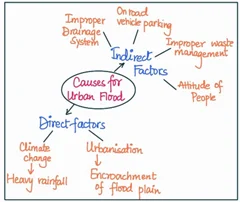Answer:
| Approach:
Introduction
- Brief about understanding causes and enhancing preparedness for Rising Urban Floods.
Body
- Discuss about the mechanisms for preparedness.
- Causes of Mitigating Urban Floods.
Conclusion
- Conclude your answer with the key Strategies for mitigation.
|
Introduction:
India’s urban population is projected to reach 40.76% by 2030, emphasizing the importance of urbanization for economic growth. Inadequate urban planning and climate change contribute to urban flooding, as witnessed in Hyderabad (2020), Chennai (2015), and Bengaluru (recently).

Body:
- Causes:
- Rapid Urbanization: Unplanned urban growth and inadequate drainage infrastructure contribute to increased surface runoff, leading to flooding in urban areas.g Mumbai.
- Climate Change: Changing rainfall patterns and extreme weather events associated with climate change amplify the risk of urban floods.g Maharashtra.
- Deforestation: Loss of natural vegetation and increased impervious surfaces hinder infiltration, causing rapid runoff and overwhelming drainage systems.g According to ICED 2022 report, the country has experienced a significant increase in annual runoff by approximately 1.3 billion cubic meters due to reduced infiltration and increased surface runoff.
- Poor Drainage Systems: Insufficient maintenance, blockages, and inadequate capacity of drainage networks impede water flow, exacerbating flood risk.
- Encroachment of Water Bodies: Construction on water bodies reduces their storage capacity, displacing water into urban areas during heavy rainfall.
- Mechanisms for Preparedness:
- Urban Planning and Zoning: Implementing proper urban planning strategies, including land-use zoning and flood-sensitive construction practices, can minimize flood vulnerability.Like
- Improved Drainage Infrastructure: Investing in robust drainage systems, including storm water management, retention ponds, and green infrastructure, enhances water drainage capacity.
- Early Warning Systems: Deploying efficient and timely warning systems that provide real-time rainfall data and flood forecasts enables proactive response measures.
- Flood Mapping and Risk Assessment: Conducting comprehensive flood mapping and risk assessments helps identify high-risk areas and facilitates targeted mitigation measures.
- Public Awareness and Community Engagement: Educating communities about flood risks, disseminating information on evacuation routes, and fostering community participation in preparedness activities strengthens resilience.
- Emergency Response Planning: Developing effective emergency response plans, including coordination mechanisms, trained personnel, and stockpiling essential supplies, ensures a swift and organized response during flood events.
Conclusion:
Urban floods and implementing robust preparedness mechanisms, the risk associated with such events can be significantly reduced. Efforts focused on urban planning, improved drainage infrastructure, early warning systems, community engagement, and emergency response planning are vital for minimizing the impact of urban floods and safeguarding vulnerable urban populations.
